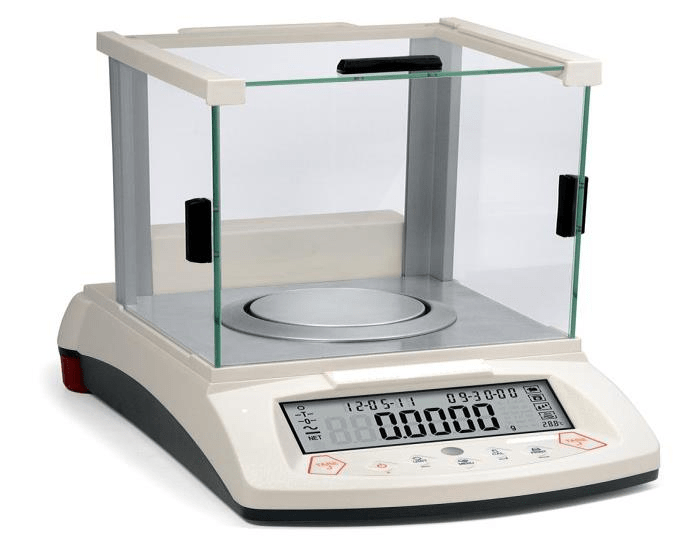A high-precision tool for measuring mass precisely, analytical balances usually measure mass to within 0.0001 grams (0.1 mg) or less. For quantitative chemical analysis, these balances are frequently utilized in scientific settings.
Table of Contents
An analytical balance is a very precise laboratory balance used to precisely calculate the mass of an object. The items could be powders, liquids, solids, or granular materials. Another name for it is class II balance, or laboratory balance.
Principle
The basis of an analytical balance’s operation is the use of an electromagnetic force compensation mechanism to compare an unknown mass with a known mass. Gravity causes an object on the balancing pan to exert a downward force. An electromagnetic force produced by a current flowing through a coil in a magnetic field opposes this force. The mass of the object determines how much current is needed to balance the force.

Parts of Analytical Balance
- The platform used to weigh an object is called a “weighing pan.”
- Draft Shield: A clear covering that encloses the weighing pan to keep it shielded from dust and air currents and to guarantee precise readings.
- The electromagnetic force produced by an electromagnetic coil counteracts the object’s weight.
- A load cell, also known as a sensor, measures an object’s force and transforms it into an electrical signal.
- Display: Digital: Indicates the mass as measured.
- A level indicator makes sure the balance is precisely level so that readings are correct.
- Tare Button: Pressed to reset the balance in order to weigh an item.
- By comparing the balance’s results to a recognized standard, the calibration mechanism makes sure the device is accurate.
Types of Analytical Balance
- Conventional balances that employ a mechanical system of beams and counterweights are known as mechanical analytical balances. Because they are less convenient and precise than computerized balances, they are less used today.
- Electronic Analytical Balances: These days, balances use electromagnetic force correction and electronic sensors to measure mass precisely. In laboratories, these are the most commonly utilized kind.
- Semi-Micro Analytical Balances: Usually accurate to 0.00001 grams (0.01 mg), these balances can measure extremely minute masses.
- Micro Analytical Balances: Capable of measuring to 0.000001 grams (1 µg), these balances are utilized in specialist applications such as pharmaceutical research and are designed for ultra-precise measurements.
Examples of Use
- Pharmaceutical Industry: Accurate drug component measurement for formulation and quality assurance.
- Chemical Laboratories: Precise measurement of substances for examinations and reactions.
- Environmental analysis: Quantifying pollutants and toxins using minimal sample weights.
- Food Industry: Making sure product ingredients are proportioned correctly.
- Materials science: Calculating the mass of research-worthy tiny samples of novel materials.
Example Analytical Balances
- Sartorius Secura: Well-known for its excellent precision and intuitive interface, this balance is appropriate for everyday laboratory tasks.
- The Mettler Toledo XPR Balance is perfect for high-precision applications since it has sophisticated features including automated internal calibration and static detection.
- Ohaus Explorer Balance: Often seen in academic and scientific settings, this device has a wide touchscreen and user-friendly software.
When precise mass measurement is needed in any laboratory setting, they are a necessary instrument. In many scientific and industrial domains, choosing the appropriate balance for particular requirements and ensuring accurate and dependable findings are made easier with a thorough understanding of their principles, parts, types, and applications.
Frequently Asked Question(FAQ)
What are the principles of analytical balance?
The “magnetic force restoration” theory underlies the operation of analytical balance. It’s an electromagnetic balance that uses an electromagnet to determine an object’s mass. These balances measure the force acting on the balancing pan in a downward direction rather than the mass directly.
What are the four working principles of laboratory balance?
Four components make up the accuracy test for lab balances: corner load, linearity, calibration, and repeatability.
Why is analytical balance important?
Because they are capable of measuring weight variations as small as one decimal place. Often, it has a draft shield to help block off dust or drafts that can unintentionally change the weight.
Related Article


